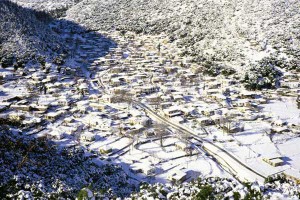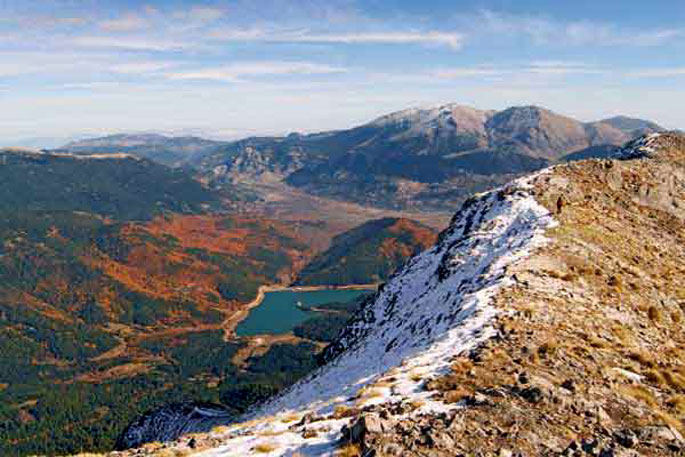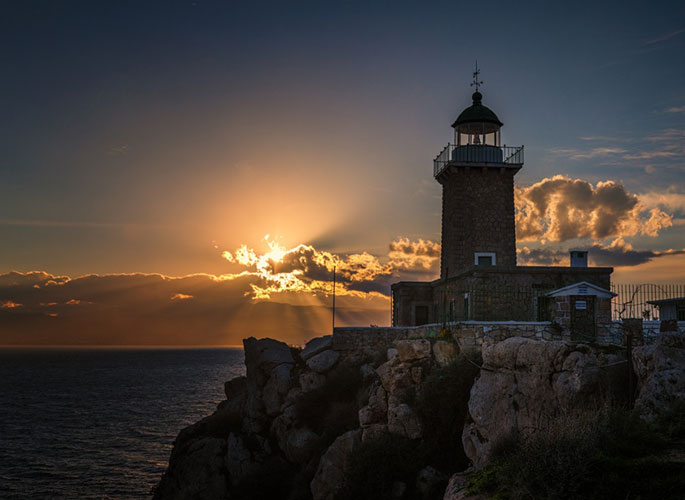Every summer a series of cultural events take place for all, locals and visitors of Corinth. Concerts, plays, exhibitions, sport events, are but a few of the happenings during summer. Almost every day there is something to enjoy or take part it. One of the most important is the two day celebration for Saint Paul (the Apostle), towards the end of June.
Source: www.mythicalpeloponnese.gr
For the town Nemea, the beginning of fall is a celebration! It is the grape harvest! Every year at the beginning of September, a three-day celebration of Nemea’s wine producers, called “Great Days of Nemea” is organized. This event is organized by the Municipality of Nemea and the Nemea Union of Wine Producers and Viticulturists, and presents the wine wealth of the area and “Agiorgitiko”, one of the most famous wine assortments worldwide. For wine lovers, this is a great opportunity to celebrate the new harvest with the producers.
The events of the greatest vineyard of the Balkan Peninsula take place in an area that provides a significant archaeological tradition and it is defined by the wine culture. Here is the land of the wine of Fliasion, which was very popular in the ancient times because of its widespread consumption in the Nemean Games. According to tradition, on the low hill southern of the today’s plain of Nemea, near to the springs of Asopos River, king Arash built a city. This city was located in a blessed location, with the river watering the fertile plain, named Fliasia after the son of God Dionysus, Flias, who reigned here according to mythology. It is believed that it was here where they cultivated the first grapevine and they produced the first wine, the famous wine of Fliasion, rumored to accompany king Agamemnon’s rich feasts in the palace of Mycenae. The old name of Nemea was Ai Giorgis, and after that was named the grape and wine assortment, “Agiorgitiko”, admirable successor of the legendary ancient wine assortment.
The wineries that participate in the events stay open during the festival offering an amazing opportunity for everyone to familiarize themselves with the wine and its production process.
The events are centered around the promotion of the vineyard to visitors, to boost the environmental culture in order to change the way we handle and protect the product and to teach us new environment-friendly methods of cultivation and wine making.
The festival lasts 3 days and includes visits to wineries, wine tasting seminars, tours to vineyards and a series of cultural performances, concerts, exhibitions, workshops, movie nights etc.
Information:
0030 27463 60132 & 0030 27463 60118 (Municipality of Nemea)
Source: www.mythicalpeloponnese.gr
 The archaeological site of Ancient Corinth is situated in a village bearing the same name, only a few kilometers from the modern town of Corinth. The area was first inhabited during the Neolithic period, at the eastern foothills of Acrocorinth hill. It was developed in a strategic location; were land communication could be controlled between Peloponnesus and Central Greece, it had fresh water and it oversaw the fertile valley of Corinth. It was perfectly positioned and for that reason the settlement did not change location until the Middle Ages.
The archaeological site of Ancient Corinth is situated in a village bearing the same name, only a few kilometers from the modern town of Corinth. The area was first inhabited during the Neolithic period, at the eastern foothills of Acrocorinth hill. It was developed in a strategic location; were land communication could be controlled between Peloponnesus and Central Greece, it had fresh water and it oversaw the fertile valley of Corinth. It was perfectly positioned and for that reason the settlement did not change location until the Middle Ages.
Video by fabdrone
 The peak period of ancient Corinth begins with the foundation of its colonies, mainly Corcyra and Syracuse. The Corinthians introduced the trireme to Greece. Ancient Corinth was the most significant commercial destination in the Greek territory. The excavations brought to light the imposing temple of Apollo, the Agora, the temple of Octavia, the shops of Lechaion road, Apostle Paul’s Podium, the theater and the Odeon.
The peak period of ancient Corinth begins with the foundation of its colonies, mainly Corcyra and Syracuse. The Corinthians introduced the trireme to Greece. Ancient Corinth was the most significant commercial destination in the Greek territory. The excavations brought to light the imposing temple of Apollo, the Agora, the temple of Octavia, the shops of Lechaion road, Apostle Paul’s Podium, the theater and the Odeon.
Source: www.mythicalpeloponnese.gr
The archaeological site of Heraion is located 15 kilometers to the northwest of Ancient Corinth, at the end of Perachora peninsula. Excavations carried out in the region have brought to light the temple of Hera and significant remains of the early Corinthian civilization, such as an L-shaped stoa, a large cistern, dining rooms and a smaller temple.
 The temple of Hera is the most significant monument of the site. It lies near a small harbor under the lighthouse of Melagavi. The region was an important part of the Corinthian land during the early roman period. The findings in Perachora provide valuable information on Corinthian art from the geometric and archaic period. Excavations (1930-1933) were carried out at the site of Heraion and the temple of Hera Akraia, above the harbor, and Hera Limenia, by the harbor. The investigation extended to Vouliagmeni lake, and it attested the existence of remains that date back to the Neolithic, early Helladic and Mycenaean age. It is believed that a significant town called Heraion existed on the site. The findings in the area indicate that the town Oinoi was located in the area of Schoinos, and that the settlement of Therma was located in the modern town of Loutraki.
The temple of Hera is the most significant monument of the site. It lies near a small harbor under the lighthouse of Melagavi. The region was an important part of the Corinthian land during the early roman period. The findings in Perachora provide valuable information on Corinthian art from the geometric and archaic period. Excavations (1930-1933) were carried out at the site of Heraion and the temple of Hera Akraia, above the harbor, and Hera Limenia, by the harbor. The investigation extended to Vouliagmeni lake, and it attested the existence of remains that date back to the Neolithic, early Helladic and Mycenaean age. It is believed that a significant town called Heraion existed on the site. The findings in the area indicate that the town Oinoi was located in the area of Schoinos, and that the settlement of Therma was located in the modern town of Loutraki.
Video by fabdrone
Source: www.mythicalpeloponnese.gr
Every summer a series of cultural events take place for all, locals and visitors of Kiato. Concerts, plays, exhibitions, sport events, are but a few of the happenings during summer. Almost every day, from July until August, there is something to enjoy or take part it.
Source: www.mythicalpeloponnese.gr
 The ancient town of Stymphalia was probably founded in the archaic period and it was named after its first inhabitant, Stymphalos. The region belonged to the Arcadians. The town was built on the north shore of Stymphalia lake. A large part of the archaeological site lies under water. Excavations have brought to light a theater and a palaestra that date back to the Classical period. Access to the site is possible only through a path that starts from the Frankish monastery of Zarakas, a few kilometers from the head of the ex-municipality of Stymphalia, Kalianoi village. Anastasios Orlandos carried out the excavations at the archaeological site of Stymphalia from 1924-1930.
The ancient town of Stymphalia was probably founded in the archaic period and it was named after its first inhabitant, Stymphalos. The region belonged to the Arcadians. The town was built on the north shore of Stymphalia lake. A large part of the archaeological site lies under water. Excavations have brought to light a theater and a palaestra that date back to the Classical period. Access to the site is possible only through a path that starts from the Frankish monastery of Zarakas, a few kilometers from the head of the ex-municipality of Stymphalia, Kalianoi village. Anastasios Orlandos carried out the excavations at the archaeological site of Stymphalia from 1924-1930.
Source: www.mythicalpeloponnese.gr

Nemea is a land of legends and traditions. It was the home land of the Nemean Lion, slayed by the legendary Hercules. The Nemean lion was a vicious monster that lived in a cave on mount Triton. Hercules trapped the beast and then killed it with his club. The archaeological site is located on the foothill of the mountains of Arcadia, 333 meters above sea level. The strategic location of Nemea and its climate were the reason that the Panhellenic Games of Nemean were held in the region. During the winter, the region was turned into a swamp, during the summer though it was the ideal place to practice sports. The most significant monuments of Nemea are the temple of Zeus and the Stadium. Since Nemea did not have residents, the management of the games belonged initially to Cleonae and then to Argos.
Source: www.mythicalpeloponnese.gr
Ancient Sicyon is located on the mound of Vasiliko, a village 4 kilometers to the southeast of Kiato, head of the municipality of Sikyona. In antiquity it was bordered with Corinth to the east, with the Achaean Pellini to the west, and the Arcadian Fliounta and Stymfalos to the south. It was built on a 2300 acres plateau. According to Strabo, Sicyon was located initially by the sea until Demetrios Poliorketes built a new town on the plateau. Demetrios conquered the city and persuaded the Sikyonians to move to the acropolis, leading them to a high triangular plateau. He named the city Demetrias. Most of the public buildings were constructed under the reign of Demetrios and later by Aratos who incorporated the city into the Achaean league. The ancient theater and the roman baths are the most imposing monuments of Ancient Sicyon.
The American School of Classic Studies conducted the first excavations in Ancient Sicyon at the site of the ancient theater, between 1886 and 1898. The excavations were centered around the area of the ancient agora and brought to light a temple, a palaestra, a Bouleuterion, a long Stoa, and a part of the theater’s cavea. All the visible monuments of ancient Sicyon were set according to the Hippodamus Urban Planning System, typical to the Hellenistic town, thus oriented to the four cardinal points.
The ancient theater was constructed during the first years of the foundation of the town, around 303 B.C., on the upper mountain plateau of the town. It consisted of the most adequate place to build a theater. Part of the seats was hewn to the rock. The excavations have brought to light the skene, the orchestra and part of the tiers of seats as well as the two vaulted passages leading to the upper diazoma. It is considered as one of the most spectacular theaters of this size, the diameter of its orchestra being 24 meters and the cavea 125 meters. The structure combines the technique of poros stone construction and the chiseling in the natural rock of the hillside. The prohedriai (seats of honor) were located at the first row. The two vaulted passages, leading to the cavea, consisted of the main entrances for the audience. They were 16 meters long and 2.60 meters high and they are preserved in good condition. The orchestra was made of packed earth, while a drainage channel covered by stone slabs runs vertically through the orchestra and ends in the rear of the Skene. The parodoi provided gated entrances similar to those in Epidaurus. The planning and the construction of the theater date back to the late 4th century or early 3rd B.C. The site was used for theatrical performances and political meetings by the citizens of Sicyon.
To the northwest of the theater lies the stadium. Its track is 207 meters long. Part of the retaining wall of sling can be visible though it has not been excavated yet. The stone roman baths, to the north of the agora, are preserved in good condition and they host, at the present, the Archaeological Museum. The visible parts of the ancient construction attest the existence of a large edifice structured around a central courtyard that dated to the 1st or 2nd century A.D.
The foundations of the Bouleuterion of Hellenistic Sicyon have also been discovered. It consisted of a spacious square edifice (40.5 × 41.15 meters) with four internal rows of four columns and a stoa along the façade, on the north side. Both the Bouleuterion and the stoa date to the Hellenistic Period and they were restored in later periods.
The Gymnasium was a large square building. The palaestra was built to the west of the agora, in two levels because of the nature of the ground. It consisted of the basic part of the Gymnasium. The lower lever, 72 × 36 meters, is the most ancient and it dates back to the early 3rd century B.C. The east part, considered the main Gymnasium, was constructed around 280 B.C. by the father of Aratus, Kleinias. The upper part was added later during the roman period.
Another monument worth visiting is the ruins of the archaic temple, near the Agora precinct, built in the 7th century. The temple was dedicated to Artemis or Apollo. It is an east oriented peripteral temple (38.07×11.55 meters) built of soft stone. The first construction phase dates back to the archaic period (6th century B.C.). The temple is of the only archaic edifice visible today. The ancient Agora extends to the east of the theater. It was the center of the excavations conducted by the Archaeological Society. The southwest side of the Agora was bordered by the large stoa, the Bouleuterion, the palaestra and a second stoa to the south of the palaestra The temple was located in the Agora.
Source: www.mythicalpeloponnese.gr
The first settlers of Pheneos were the Pelasgeans. Later, in 1900 B.C. it was inhabited by the Arcadians. They were succeeded by the Achaeans, in 1500 B.C., who created the Mycenaean center of Pheneos and participated to the Trojan War with sixty soldiers under the rule of Agathenoras, king of the Arcadians.
 The acropolis of ancient Pheneos is located near the modern village of Ancient Pheneos, or Kalyvia, to the northwest of the valley of Pheneos. The Ephor of Argolid, E. Deilaki, carried out excavations during the period 1958-1961 and brought to light Asclepeion. It measured 10 × 6.10 meters. Two enormous marble sandaled feet were found on a rectangular pedestal. A female marble head was found behind the pedestal. The two statues that date to 150 B.C. depict Asclepius and Hygeia. All of the findings are exposed in the local archaeological museum. The most impressive is the marble head of Hygeia.
The acropolis of ancient Pheneos is located near the modern village of Ancient Pheneos, or Kalyvia, to the northwest of the valley of Pheneos. The Ephor of Argolid, E. Deilaki, carried out excavations during the period 1958-1961 and brought to light Asclepeion. It measured 10 × 6.10 meters. Two enormous marble sandaled feet were found on a rectangular pedestal. A female marble head was found behind the pedestal. The two statues that date to 150 B.C. depict Asclepius and Hygeia. All of the findings are exposed in the local archaeological museum. The most impressive is the marble head of Hygeia.
Source: www.mythicalpeloponnese.gr
Melagavi or Heraion lighthouse was built in 1897 on the Agrilaos peninsula, in the golf of Alkyonides Islands. In 1947, the building was renovated and repaired. Its outline is T shaped, and it has a rectangular light tower. The Heraion lighthouse is well known in the area. It is made of stone and it constitutes a typical example of lighthouse architecture.
Source: www.mythicalpeloponnese.gr



















